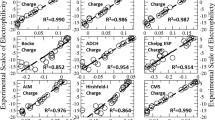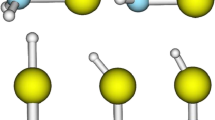Abstract
To investigate the hydrogen evolution ability of the cluster ConMoS (n = 1–5), this paper based on density functional theory, using the B3LYP generalization and def2-TZVP basis set. In this paper, the cluster was structurally optimized and theoretically analyzed by the Gaussian09 package under multiple spin multiplexes. The optimized conformation of the cluster was mostly in stereo form; in the first step of the hydrogen evolution reaction, the analysis of the cluster HOMO diagram and the water molecule LUMO diagram, the energy level difference, the d-band center, Gibbs free energy and adsorption energy showed that the electrons of configurations 5-a and 4-a were more likely to jump from the HOMO orbital to the water molecule LUMO orbital, and 5-a and 4-a showed excellent activity, they finally formed the ConMoS-Hads model; in the second step of the hydrogen evolution reaction, the Co atom were a potential active site, and analysis of energy level differences and bond level revealed that the configurations 5a-Hads and 4a-Hads showed good desorption capacity compared to the other configurations, and their adsorbed H atoms were more readily shed to complete the reaction with more rapid hydrogen evolution; in summary, configurations 5-a and 4-a were determined to be the favored configurations of the cluster with excellent catalytic activity.








Similar content being viewed by others
Data availability
If necessary, the data of this study can be provided to the corresponding author within a reasonable range.
Code availability
This article does not apply the term.
References
Norouzi N (2021) Assessment of technological path of hydrogen energy industry development: a review. Iran (Iranica) J Energy Environ 12:273–284
Falcone PM, Hiete M, Sapio A (2021) Hydrogen economy and sustainable development goals: review and policy insights. Curr Opin Green Sustain Chem 31:100506
Qin Y, Fang ZG, Zhang W, Li LH, Liao W (2020) The study on the catalytic properties of cluster Co3NiB in the hydrogen evolution reaction. J Jiangxi Norm Univ (Nat Sci Ed) 44:56–62
Qin Y, Fang ZG, Zhao LL, Liao W, Xu Y (2021) The study on the dynamics and thermodynamics of isomeric transformation of cluster Co3NiB2. J Jiangxi Norm Univ (Nat Scie Ed) 45:67–74
Zheng XX, Fang ZG, Qin Y, Hou QQ, Wu TH, Mao ZL (2021) Electronic Properties of Cluster Fe3Ni3. J Guizhou Univy (Nat Sci) 38:7–12
Fang ZG, Wang ZY, Zheng XX, Qin Y, Mao ZL, Zeng XY, Zhu YW, Wang Q (2022) Study on the dolarizabilitydipole momentand density of states of cluster Co3NiB. J Guizhou Univ (Nat Sci) 39:17–24
Hou QQ, Fang ZG, Qin Y, Zhu YW (2021) Study on the polarization of Fe4P clusters. J Guangxi Norm Univ (Nat Sci Ed) 39:140–146
Li Y, Hou XW, Gu J, Mikhaylova V, Chen KL, Zhang HM, Han SM (2021) Open and close-ended CoMoS3 nanotubes for hydrogen evolution in acidic and basic conditions. J Energy Chem 57:34–40
Zhou LJ, Han ZX, Li WX, Leng WX, Yu Z, Zhao Z (2020) Hierarchical Co-Mo-S nanoflowers as efficient electrocatalyst for hydrogen evolution reaction in neutral media. J Alloy Compd 844:156108
Xu J, Mao M, Yu H (2020) Functionalization of sheet structure Co-Mo-S with Ni(OH)2 for efficient photocatalytic hydrogen evolution. Res Chem Intermed 46:1823–1840
Fan JP, Ekspong J, Ashok A, Koroidov S, Gracia-Espino E (2020) Solid-state synthesis of few-layer cobalt-doped MoS2 with CoMoS phase on nitrogen-doped graphene driven by microwave irradiation for hydrogen electrocatalysis. RSC Adv 10:34323–34332
Wang S, Ge XB, **ao JY, Huang LY, Liu J, Wu J, Yue WJ, Yang XH (2020) Amorphous CoMoSx/N-doped carbon hybrid with 3D networks as electrocatalysts for hydrogen evolution. Catal Lett 151:1720–1727
Lu YK, Guo XX, Yang LY, Yang WF, Sun WT, Tuo YX, Zhou Y, Wang ST, Pan Y, Yan WF, Sun D, Liu YQ (2020) Highly efficient CoMoS heterostructure derived from vertically anchored Co5Mo10 polyoxometalate for electrocatalytic overall water splitting. Chem Eng J 394:124849
Li P, Zhuang ZH, Du C, ** effect on the electrocatalytic performance of hierarchical CoxMoyS nanosheet arrays for hydrogen generation and urea oxidation. ACS Appl Mater Interfaces 12:40194–40203
Wang B, Liu YH, Hao JH, Zhong JB, Yu FR, Zhang KW, Shen H, Mao BD (2018) Synergetic optimization via composition-dependent nanostructuring in Co-Mo-S Electrocatalysts for efficient hydrogen evolution in alkaline solution. Int J Electrochem Sci 13:3501–3515
Ren X, Wu D, Ge RX, Sun X, Ma HM, Yan T, Zhang Y, Du B, Wei Q, Chen L (2018) Self-supported CoMoS4 nanosheet array as an efficient catalyst for hydrogen evolution reaction at neutral pH. Nano Res 11:2024–2033
Liu WJ, Wang XF, Yu HG, Yu JG (2018) Direct photoinduced synthesis of amorphous CoMoSx cocatalyst and its improved photocatalytic H2-evolution activity of CdS. ACS Sustain Chem Eng 6:12436–12445
Wu ZX, Guo JP, Wang J, Liu R, **ao WP, Xuan CJ, **a KD, Wang DL (2017) Hierarchically porous electrocatalyst with vertically aligned defect-rich CoMoS nanosheets for the hydrogen evolution reaction in an alkaline medium. ACS Appl Mater Interfaces 9:5288–5294
Liu YR, Shang X, Gao WK, Dong B, Li X, Li XH, Zhao JC, Chai YM, Liu YQ, Liu CG (2017) In situ sulfurized CoMoS/CoMoO4 shell–core nanorods supported on N-doped reduced graphene oxide (NRGO) as efficient electrocatalyst for hydrogen evolution reaction. J Mater Chem A 5:2885–2896
Guo JX, Zhang XQ, Sun YF, Tang L, Zhang X (2017) Self-template synthesis of hierarchical CoMoS3 nanotubes constructed of ultrathin nanosheets for robust water electrolysis. J Mater Chem A 5:11309–11315
Car R, Parrinello M (1985) Unified approach for molecular dynamics and density-functional theory. Phys Rev Lett 55:2471–2474
Purgel M (2022) Rigid, strained, and flexible: a DFT study of a backbone-affected monohydride formation of salen and salan complexes. Theor Chem Acc 141:1–8
Du JB, Feng ZF, Zhang Q, Han LJ, Tang YL, Li QF (2019) Molecular structure and electronic spectrum of MoS2 under external electric field. Acta Physica Sinica 68:173101
Kargar H, Behjatmanesh-Ardakani R, Torabi V, Kashani M, Chavoshpour-Natanzi Z, Kazemi Z, Mirkhani V, Sahraei A, Tahir MN, Ashfaq M, Munawar KS (2021) Synthesis characterization crystal structures DFT TD-DFT molecular docking and DNA binding studies of novel copper (II) and zinc (II) complexes bearing halogenated bidentate N O-donor Schiff base ligands. Polyhedron 195:114988
Luo SC, Nie D, Li Z, Sun XY, Hu L, Liu XY (2020) Effects of carboxylic acid auxiliary ligands on the magnetic properties of azido-Cu (II) complexes: a density functional theory study. Polyhedron 182:114506
Byskov LS, Hammer B, Nørskov JK, Clausen BS, Topsøe H (1997) Sulfur bonding in MoS2 and Co-Mo-S structures. Catal Lett 47:177–182
Liebing S, Martin C, Trepte K, Kortus J (2015) Electronic and magnetic properties of ConMom nanoclusters from density functional calculations (n+m=x and 2≤x≤6 atoms). Phys Rev B 91:155421
Juárez-Sánchez OJ, Perez-Peralta N, Herrera-Urbina R, Sanchez M, Posada-Amarillas A (2013) Structures and electronic properties of neutral (CuS)Nclusters(N = 1–6): a DFT approach. Chem Phys Lett 570:132–135
Peng L, Wu SY, Guo JX, Zhong SY, Chen XH (2018) Theoretical investigations on the structural, electronic and spectral properties of VFn(n=1–7) clusters. Zeitschrift für Naturforschung A 73:1091–1104
Lu T, Chen F (2012) Multiwfn: a multifunctional wavefunction analyzer. J Comput Chem 33:580–592
Zhou GD, Duan LY (1995) Fundamentals of Structural Chemistry. Peking University Press
Yang S, Rao D, Ye J, Yang S, Zhang C, Gao C, Zhou X, Yang H, Yan X (2021) Mechanism of transition metal cluster catalysts for hydrogen evolution reaction. Int J Hydrog Energy 46:3484–3492
Zhou X, Yang S, Yang H, Gao S, Yan X (2022) Mechanism of heteroatom-doped Cu5 catalysis for hydrogen evolution reaction. Int J Hydrog Energy 47:7802–7812
Nørskov JK, Bligaard T, Logadottir A, Kitchin JR, Chen JG, Pandelov S, Stimming U (2005) Trends in the exchange current for hydrogen evolution. J Electrochem Soc 152:3
Funding
Project supported by the Key Program of the National Natural Science Foundation of China (Grant No.51634004), National Innovation and Entrepreneurship Training Program for College Students (Grant No.: 202110146027, 202010146009, 202010146016).
Author information
Authors and Affiliations
Contributions
Z-Y W contributed to writing, data management, methodology. Z-G F contributed to conceptualization, project Management. J W contributed to article proofreading. Z-L M contributed to verification, methodology. Q-Q H contributed to article proofreading, software. T-H W contributed to article proofreading, data management. X-X Z and J S contributed to proofreading the article.
Corresponding author
Ethics declarations
Conflicts of interest
The authors declare that they have no conflict of interest.
Additional information
Publisher's Note
Springer Nature remains neutral with regard to jurisdictional claims in published maps and institutional affiliations.
Rights and permissions
Springer Nature or its licensor (e.g. a society or other partner) holds exclusive rights to this article under a publishing agreement with the author(s) or other rightsholder(s); author self-archiving of the accepted manuscript version of this article is solely governed by the terms of such publishing agreement and applicable law.
About this article
Cite this article
Wang, ZY., Fang, ZG., Wang, J. et al. Study of the hydrogen evolution properties of cluster ConMoS (n = 1–5) using density functional theory. Theor Chem Acc 142, 2 (2023). https://doi.org/10.1007/s00214-022-02943-0
Received:
Accepted:
Published:
DOI: https://doi.org/10.1007/s00214-022-02943-0




